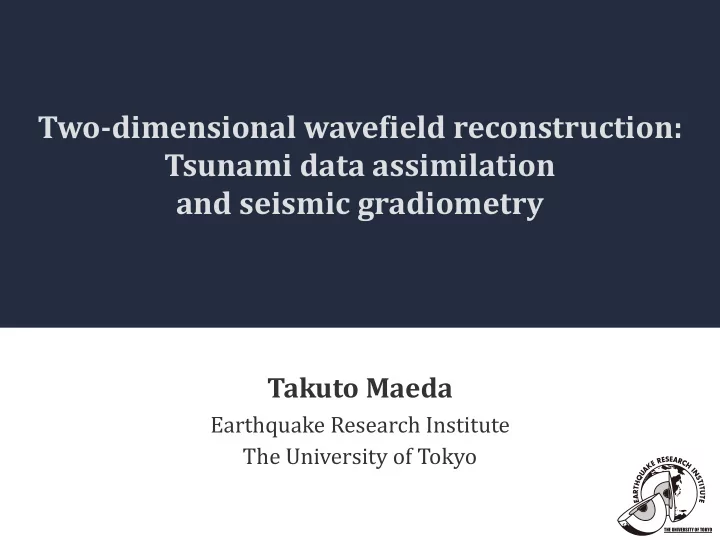

Two-dimensional wave/ield reconstruction: Tsunami data assimilation and seismic gradiometry Takuto Maeda Earthquake Research Institute The University of Tokyo THE UNIVERSITY OF TOKYO
The “Large- N ” arrays all over the world USArray Hi-net & Strong Motion Networks in Japan (Okada et al., 2004) Long Beach Array (Lin et al., 2012) The AlpArray Initiative (http://www.alparray.ethz.ch)
Development of dense tsunami networks Cabled pressure gauge & seismographs (Rabinovich and Eble, 2015, PAGEOPH) (www.bosai.go.jp) (noaa.gov)
Motivation ■ How to utilize these large dataset ? ■ for understandings inhomogeneous subsurface structure ■ for more deep understandings of physics of wave propagation in heterogeneous media ■ for real-world application, in particular early warnings of earthquakes and tsunamis ■ SigniTicant improvement on station density compared to wavelength ■ Obtain more information through two-dimensional continuous waveTield modeling ■ Independent two topics on tsunami and seismic wave propagation
The new S-net ■ Super dense realtime network for seismic & tsunami wave monitoring ■ A part of the network started observation from 2016 ■ With a dense network, we may be able to track 2D tsunami wave/ield ■ No source is necessary for forecasting ? (www.bosai.go.jp)
A new approach: Data assimilation ■ Not relying on source data Event(Trig. ■ Estimate wave/ield ■ Directly Tit tsunami simulation Tsunami( Tsunami( Data Simulation with observation Assimilation ■ Estimated waveTield is further used for better Tit of tsunami at next timestep Current' tsunami(wave5ield ■ Always running = monitoring ■ Tsunami forecast can be done whenever it is necessary Tsunami(Forecast
Data assimilation as a feedback system ■ #1) Forecast by numerical simulation of linear shallow water ,- $, & + ,/ $, & # $, & ← ! "() * ! " $, & − Δ1 ,$ ,& $, & − 3ℎ ,! $, & $, & − 3ℎ ,! $, & # $, & ← - "() # $, & ← / "() # # - " 51, / " 51, ,$ ,& # $ : tsunami height, M & N : tsunami Tlow velocity ! " -, / $ 3 ℎ ■ #2) Assimilation: A Feedback from observation residual # $ - " * $, & ← ! " # $, & + :;< $ 8 9 , & 8 9 − ! " # $ 8 9 , & 8 9 ! " 6 $, &; $ 8 9 , & 8 9 ! " , = ! :;< ■ A weight factor W can be estimated by the optimum interpolation algorithm based on the station layout ■ The forecasting-assimilation cycle is repeated with updating observed data in real time (Kalnay, 2003; Maeda et al., 2015)
Far-/ield tsunami forecast by the DA Real-world post casting Numerical forecast experiment with Cascadia Initiative OBPGs (Gusman et al., 2016, GRL) ■ Reconstruct continuous waveTield through assimilation (Maeda et al., 2015, GRL)
Near-/ield pressure problem Forward Simulation New Data Assimilation ■ Only relative tsunami height can be measured by pressure gauges Pressure measurement Pressure estimation ■ Co-seismic seaTloor deformation beneath stations results Tictitious offset on tsunami True tsunami height True tsunami height estimation ■ Recent updates of data assimilation technique succeeded in separating between coseismic Sea/loor deformation Sea/loor deformation estimation seaTloor deformation and true tsunami height
Dense seismic observation ■ Station separation ~ 20 km ■ Targeting long-period band: ■ Wavelength ~ 100 km @ 25 s ■ We can treat the traces as a continuous wave/ield ■ Observation is only on the ground surface: still difTicult to assimilate to numerical models ■ Data-driven approach: obtain more information from wave- Tield modeling (Maeda et al., 2011, JGR)
Seismic gradiometry ■ Taylor series expansion of seismic waveTield station grid point ■ Estimation of wave at grid point and spatial gradients by the least square u obs = Gm (Spudich, 1995 JGR; Liang and Langston, 2009 JGR) ■ Inverse problem at each grid, however it only depends on station layout ■ Pre-computation of the kernel save the computational cost
Wave/ield characterization ■ Divergence & rotation vector with free surface B. C. ■ Convert derivative wrt depth to that wrt horizontal directions by B.C. (Shapiro et al. , 2000, BSSA) ■ Slowness estimation ■ observation = (amplitude term) x (propagation term) ■ A ( x ) : Term related to geometrical spreading and/or radiation pattern ■ B ( x ) : Slowness (arrival direction & phase speed) (Langston, 2007, BSSA)
Synthetic test Goodness-of-Fit div/rot decomposition@25-50 s div rot (z) •Hi-net with SG act as div&rot-seismometers •Love & Rayleigh decomposition
Example: 2005 Off-Tohoku outer-rise eq. ■ In-situ estimation of slowness vector (speed & direction) (Maeda et al., submitted)
Divergence & rotation decomposition ■ Decompose the vector seismic waveTield into divergence (P&Rayleigh) and rotation (z) (SH&Love ) (Maeda et al., submitted)
Concluding remarks ■ The full utilization of recent dense arrays enables us to track seismic/tsunami waves as spatially continuous waveTield ■ Space-time visualization helps deep understandings of complicated wave phenomena ■ Spatial waveTield is not only the simple visualization but is a target of data analysis: ■ Seismic gradiometry ■ Data assimilation ■ Potentially useful for next-generation EEW? ■ Next challenge: Assimilation of seismic waves ? Acknowledgement : We used Hi-net records provided by National Research Institute for Earth Science and Disaster Resilience.
Recommend
More recommend